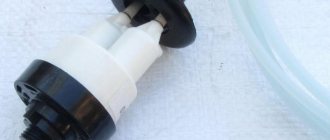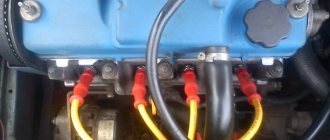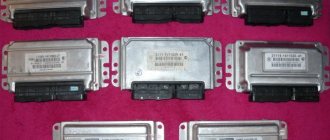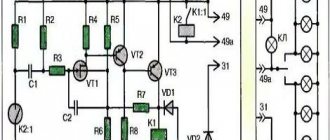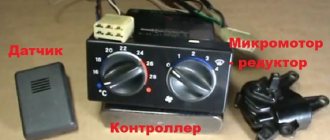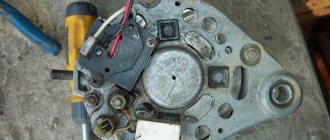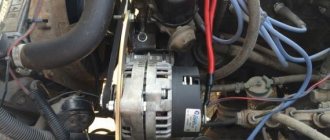Print this article Font size 16
The catalyst is a unit that serves to destroy nitrogen compounds that negatively affect the atmosphere and the environment. The device turns them into harmless substances - nitrogen, water and carbon monoxide.
Depending on the year of production of the VAZ 2114, they are equipped with catalysts that meet the requirements of Euro 2 or Euro 3 (2003-2008 and 2008-2013 model years, respectively).
Removing the catalyst. Pros and cons, consumption, firmware - we reveal all the secrets
Often my blog (and my channel) receives a lot of questions regarding the catalyst, and some readers still have many misconceptions in their heads. One of them (for example) is that if you remove this part of the muffler, then it will be VERY bad for the car, it will literally stand up and refuse to go! I decided to answer all the questions at once, today we will talk: - is it worth removing it or not (what are the pros and cons of such manipulation), what will be the consumption after cutting it out, is it necessary to flash the ECU (and what are the consequences of this), and a couple words about “deception”. In general, it will be interesting, as usual, the video version at the end...
THE CONTENT OF THE ARTICLE
At the very beginning, I would like to say that this unit IS NOT SOMETHING IMPORTANT for the car. Yes, now they will fly at me “a bunch of stones”, they say - what are you saying, but what about ECOLOGY? But if we put aside all the exclamations of the “greens”, then a car without a catalyst will work BETTER, CONSUMPTION will be lower, and the POWER will increase a little.
What is needed to install a VAZ 2114 flame arrester?
In order to dismantle a worn catalyst and replace it with a flame arrester, you will need:
- Box for repair. In outdoor conditions, using a jack is extremely inconvenient to replace. The work will be carried out much more accurately if it is carried out in an inspection pit or using a lift.
- Equipment. It can be divided into:
- assembly (welding machine);
- dismantling (grinder cutter);
- additional (portable lamp, vice, etc.).
- Tool. In addition to the standard set, non-standard keys may be required for dismantling.
Why do you need a catalyst?
I already have an article - what is it , I won’t repeat it. You need to understand that a catalyst (and scientifically, a catalytic converter) is needed only to clean the car's exhaust from harmful emissions and make them less harmful.
In simple words, it purifies harmful gases (while glowing almost “red hot”) and “almost” harmless CO2 and N2, O2 emerge from harmful CO, CH and other compounds. This way we save the environment at least a little.
Its structure is quite simple - it is a thickened pipe, which inside has something like a honeycomb, only long and hollow. They are usually made of ceramic elements coated with noble metals (usually platinum group metals are used - iridium, rhodium, palladium).
It is because of this that its cost, to put it mildly, is not small! From 30 to 150,000 rubles, it all depends on the class of the car and its volume.
In order for gases to transform from toxic to less harmful, the temperature of the catalyst must be about 750 degrees Celsius, otherwise the chemical reaction will not occur. The gases that come out of a car engine have a temperature of approximately 500 - 550 degrees Celsius (which is not enough), when they pass through the catalyst, a chemical reaction occurs with the release of heat - thus, the heating is exactly what is needed (750 - 900 degrees).
The catalytic converter is knocked out, is this bad for the car?
As I wrote above, this is simply an environmental system, and if it is not there, then the car, on the contrary, will improve its characteristics (power, consumption). To put it simply, initially the engine doesn’t care about this converter, but it creates an obstacle in the muffler, overcoming which takes part of the engine’s energy (more on this below).
But why on many cars, if this unit fails (say, melted, clogged or crumbled), the CHECK ENGINE and the car begins to behave abnormally, traction disappears, sometimes it trots a little, and simply may not start at all.
And here, friends, everything is simple. If the catalyst is melted or clogged, then the exhaust gases cannot pass through it normally, which means that some returns back into the combustion chamber and makes the newly introduced combustible mixture less efficient. The motor is choking itself.
If there is no melting, but the “CHECK” light comes on, then perhaps it has simply worn out due to high mileage. In modern cars there are so-called oxygen sensors (lambda umbrellas), one is located in front of the catalyst, the other after and detects the presence of harmful compounds; if their percentage has increased, then the second (or also called the lower “lambda”) gives a signal that the converter is not working ( or it doesn’t do its job as it should) AND IT NEEDS TO BE REPLACED. By the way, some cars may not even start (a tribute to the environment).
Thus, by knocking out or removing it, you simply free the car’s exhaust tract from the obstacle in the form of a filter and lower its environmental standards. BUT AGAIN - THIS DOES NOT AFFECT THE RESOURCE OF THE POWER UNIT !
BUT in order for your car to drive normally, you need to upgrade to a lower environmental class (usually EURO2) or install a fake one. Otherwise, the program in the ECU will not allow you to drive normally.
Replacement on a 16-valve engine
In the case of a 16-valve power unit, the catalyst is included in the design with the output manifold. Therefore, look for it behind the cylinder block directly in the engine compartment.
To replace the unit, you will need a zero resistance catalytic converter. This insert is popularly called a spider. It is quite possible to complete the work in normal garage conditions. Just keep in mind that to gain access to this element you will have to dismantle the fuel rail.
The nuance of dismantling the 16-valve engine is the presence of two lambdas.
- The first is located directly on the catalyst. It serves to adjust the fuel mixture;
- The second is located on the flange after the device. It is called ecological. If this lambda is not in place, the sensor will immediately generate an error, the injection will stop working properly, thrust will increase and fuel consumption will increase.
There are two ways to solve this issue:
- If you bought a spider for one regulator, the electronic control unit can be upgraded to Euro 2 from the current Euro 3. But such a spider has a serious drawback - the only thread for the lambda is on the flange. To mount the injection lambda there, you will have to assemble an extension cord from a wire and two connectors, called mother-father.
- If it is a spider with two regulators, the injection lambda is mounted in a standard socket. The thread for the second sensor is plugged or a dummy for the electronic control unit is installed in its place. In the second situation, there is no need to reflash the ECU.
Firmware for EURO2 and snag – what does this mean?
As I wrote above, the second oxygen sensor (lower lambda) controls harmful emissions. Their number is now strictly regulated by European standards, which are called “EURO”; I will not talk about EURO “0-1” now; we are interested in the second generation.
So, what is EURO2 ? It was introduced a long time ago, namely in 1996. AT that time, the cars received an innovative system, namely a catalyst. As we all know, over time it can become clogged, and the fuel then was not the same as now, it had a lot of sulfur, which contributed to the honeycombs clogging much faster, and as you and I know, the car began to choke itself. Then the engineers installed an oxygen sensor, there was only one, and it was needed to capture CO2 in the chamber in front of the catalytic converter.
If the CO2 level increased, this indirectly indicated that the catalyst was clogged (that is, a backpressure effect was manifested); the sensor sent this information to the ECU and the ignition was adjusted, namely, a decrease in the supply of the fuel mixture. Thus, the power dropped significantly, the car did not drive and the owner “willy-nilly” had to go to a service station and change this spare part.
BUT, as you and I know, the price tag is, to put it mildly, HIGH, so many owners simply removed these honeycombs and the POWER RESTORED!
But how? YES, everything is simple, the CO2 level in the chamber in front of the neutralizer dropped significantly, the oxygen sensor recorded this (that everything is in order) and the car drove cheerfully and without constraint. This suited everyone, BUT NOT ECOLOGISTS! Therefore, they introduced the EURO3 standard (now the EURO5 standard already exists). What has changed is that a second oxygen sensor (lower lambda) just appeared behind the catalyst. The principle of operation here is this : the first lambda (before the filter) records the level of harmful substances, the second (after it) should record a much lower level, because the harmful substances have decomposed.
If you remove the catalyst cells , then both sensors will record the same values (“the second one” supplies information to the ECU), thus, CHECK ENGINE will light up, the power will drop, and the car will not drive. Now this doesn't solve the problem.
What is done with firmware for EURO2? The firmware in the ECU is changed, instead of EURO3.4 standards, EURO2 standards are installed. The essence of all these actions is banal - we simply turn off the second lower lambda (only the upper one remains), the car begins to drive as expected, without underestimating the power.
But such interventions in the firmware are not entirely good. The whole point is that they don’t produce them themselves, okay, the second “lambda” is simply turned off, that is, they simply adjust the readings. Or maybe this programmer will want to put some incomprehensible algorithms into the ECU, the engine will definitely not benefit from this. You need to be very careful here.
Therefore, we found a second solution, and I think it is more correct - installing a blende. What is a snag - essentially it is a “spacer” in front of the second oxygen sensor, it seems to move it a greater distance from the exhaust gases, it detects more oxygen and starts working normally.
Now there are several options for deception:
- Empty . It's just a tube with a very thin hole at the end (the part that screws into the muffler), and an oxygen sensor is screwed into the other side. A limited amount of harmful substances from the exhaust passes through it, there are no excesses and therefore CHECK does not burn.
- With a mini-catalyst inside . That is, right in the “spacer” there are, as it were, mini honeycombs, which also clean the exhaust precisely to record normal values.
- Angular . These are both of the types described above, only they are made at an angle of 90 degrees; they are needed for difficult places.
The advantages of the decoy are that you don’t need to go into the ECU and change the standard firmware, as well as the price (knocked out the cells, screwed on the decoy and that’s it, you can spend 3,000 - 5,000 rubles).
Causes of malfunctions
The main reasons causing catalyst malfunction include:
- Poor quality fuel.
- Faulty oxygen sensor. In this case, too rich a mixture destroys the neutralizer.
- Leaks of oil and lubricating fluids. Liquids entering the working chamber.
- Prolonged operation of the engine in idle mode.
Signs of a faulty catalyst
- Loud noises from broken ceramic honeycombs.
- A characteristic smell in the cabin and from the exhaust gases released.
- Black exhaust color.
- Reduced engine power. This is especially noticeable on the rise and during acceleration.
- Unstable engine speed.
- Sometimes the case overheats so much that it begins to melt, and other parts behind it become deformed.
With extreme driving styles and/or poor road conditions, ceramic honeycombs break before their normal service life expires.
Diagnostics
For diagnosis you will need:
- tools for removing the lambda probe;
- pressure gauge;
- remote pyrometer.
A pressure gauge is installed in place of the lambda probe and the pressure is measured with the engine running. If it is more than 0.5 atm, there is most likely a problem in the converter.
Another way to check is to measure the pipe temperature with a remote pyrometer. If the converter is operating normally, the section of pipe upstream of it will be hotter than the section downstream of the catalyst. When the temperature is the same, this confirms the destruction of the ceramic carrier and the violation of flame retardant functions.
If a malfunction is detected, the catalyst on the VAZ 2114 must be immediately replaced.
Fuel consumption
After you have removed this filter, many are tormented by the question of fuel consumption - will it increase or not? Of course, he will fall (so I think), no matter what anyone says. Let's think logically - if there is this filter element, it represents an obstacle that the exhaust gases need to overcome, and accordingly the engine will spend more effort to push them through (consumption increases slightly). If this element is NOT present, then the “working out” will be much easier - fuel will be saved.
Of course, you shouldn’t expect any global savings, usually it’s about 3% (maximum), but it’s worth noting that consumption will drop slightly.
DEVICE
On Lada 2114, the catalyst was installed in the muffler. It consisted, as a rule, of a ceramic shell, in the form of a honeycomb, and a filler, in the form of rhodium, palladium and platinum. On a Euro 3 engine, instead of a ceramic shell, you can find a metal one.
Internal organization
Since the design of such a cleaning mechanism completely blocks the free passage of exhaust gases, if there is a malfunction or clogging, the cleaning insert becomes too dense and does not allow gases to pass through. This factor fully affects the operation of the engine.
Pros and cons of deletion
I have prepared a small sign with the pros and cons of what will happen if you remove the catalyst
| MINUSES | PROS |
| Increase in harmful substances in the exhaust, decrease in the environmental component | There is no need to buy a new catalyst, because it is very expensive |
| The smell of the exhaust becomes much more toxic, sometimes this exhaust penetrates into the car (it smells unpleasant) | A small increase in power (really small in terms of error, about 3%) |
| Exhaust sound. After knocking out the catalyst honeycomb, it is advisable to install a flame arrester, otherwise there will be a ringing sound from the empty “can” (especially at high speeds) | You can install a 4-2-1 or 4-1 spider , plus more power (which is said out of the blue) |
| You need to install either a fake or new firmware for EURO2 | Reduced fuel consumption (also about 3%) |
| Increasing the life of the power unit, because ceramic dust can get into the combustion chambers and wear it out prematurely |
As you can see, there are a few more advantages, the most significant is the price of this whole rework (removing it will cost several times, if not dozens of times, cheaper).
Now let's watch the video version.
In conclusion, I would like to say that removing the catalyst is NOT CORRECT AT ALL from an ECOLOGICAL point of view. After all, our planet is already polluted, and in this way you are making it even dirtier!
This is where I end, I think this material will help you make the right choice. Sincerely yours, AUTOBLOGGER.
( 309 votes, average: 4.60 out of 5)
Source
Removing the catalyst: pros and cons
When assembling modern cars, manufacturers equip vehicles with catalytic converters. These are special devices that are built into the exhaust system to remove harmful substances from exhaust gases. To make the car more environmentally friendly, the catalyst enters into chemical reactions with dangerous compounds CO, CH and NO2, as a result of which the less harmful CO2 component is released from the exhaust pipe into the atmosphere at an acceptable concentration.
What causes catalytic converter failure?
Catalytic converters, which can be purchased on the website autocatalystmarket.com in Russia, have a limited service life (100-150 thousand kilometers). Over time, the internal cellular structure of the ceramic device is destroyed, and the coating with precious metals (platinum, palladium, rhodium) is depleted, as a result of which the neutralizer is no longer able to perform its function.
Malfunctioning catalytic converters
occur for various reasons:
- use of low-quality fuel with foreign impurities;
- faulty ignition or fuel supply system;
- the entry of a large amount of motor oil into the engine, due to which the fuel does not completely burn out, and soot gets into the catalyst and clogs its honeycombs;
- mechanical shocks, due to which the ceramic base of the devices is destroyed.
Regardless of the reasons for the failure of the catalyst, removing the faulty device is considered the only correct solution. But not every car owner plans to buy and install a new converter due to the high cost of such units, while continuing to drive a car without a filter device. What are the pros and cons of such a solution?
TYPES
This cleaning device is divided into types, depending on the material on which the cleaning layer is located. It can be ceramic or metal. Shape: cube, honeycomb, or longitudinal block.
The most common type on VAZ 2114 cars is ceramic. This is due to its affordable price. But it has one negative quality - the fragility of the structure. That is, if you fall into a deep hole, your catalyst may crumble into pieces. Also, if during a long trip, when the exhaust system overheats, water gets on the cleaning device, the ceramic coating will crack and lose its tightness, and with it the benefits of its work.
With a metal catalyst, this of course will not happen, but this type of unit is not installed on the VAZ 2114.
How do cars manage without converters?
It is worth highlighting such advantages
driving without a catalyst:
- there is no need to buy a new filter device, which allows you to save a large amount of money;
- Engine power increases slightly (up to 10%);
- the ability to install a 4-2-1 or 4-1 spider instead of a catalytic converter, which allows you to further increase engine power;
- reduction in fuel consumption (also about 3-10%);
- increasing the operating life of the engine by preventing the risk of ceramic dust entering the combustion chambers.
But the decision to remove the catalytic converter also has its drawbacks.
:
- a significant increase in the release of hazardous compounds into the atmosphere, which leads to a deterioration of the environmental situation in the region;
- the appearance of a toxic smell of exhaust gases, which often penetrates into the car interior (the smell of hydrogen sulfide is felt);
- increased noise during operation of the exhaust system: if you decide to remove the catalyst, it is recommended to install a flame arrester that will reduce ringing sounds (especially when driving at high speed);
- the need to install a “fake” or reflash the ECU to the EURO2 standard, since in the absence of a catalytic converter, the CheckEngine light will always be displayed on the dashboard;
- There are often problems with the first oxygen sensor.
From the above we can draw the following conclusion
: Driving without a catalyst has its own benefits and advantages for the car, but has a detrimental effect on the environment. If government agencies and environmental services notice that a car owner is driving without a working converter, he may have serious problems. Therefore, when the catalyst wears out, it is recommended to install a new filter device.
Source
Technology for changing the catalytic converter to the 4-2-1 insert
To work, you need to prepare a set of keys for 13, 17, 19 and 22, you also need a socket head for 13 and a screwdriver with a flat blade. Parts you should purchase are two bolts with springs, a graphite connecting ring, an extension for the sensor, and a manifold gasket. Since the spider with tubes is longer than the standard neutralizer, it would not hurt to purchase a corrugation with double or triple braiding 200 mm long.
You must first remove the negative terminal from the battery. The further process of dismantling the standard part continues according to the following diagram:
- Remove the intake module using a 13mm socket, disconnect the injector wiring harness and the fuel supply hose.
- Unscrew the nuts securing the flanges of the intake pipe and catalytic converter, and then remove the pipe flange from the converter studs.
- Disconnect the oxygen sensor connectors and disconnect the wiring harness from the heat insulation shield.
- Unscrew the two nuts securing the catalytic converter bracket and remove the clamp.
- Unscrew the two bolts securing the fixing bracket to the BC and remove it.
- Unscrew the nut of the lower fastening of the rear pipe strut and remove the bolt of the front intake strut.
- Unscrew the nut of the upper fastening of the front strut and remove the wire tip, spacer and rubber bushing.
- Unscrew the upper nut of the rear spacer to the pipe and remove the spacer.
- Unscrew the nut of the cooling system pipe bracket and remove the bracket.
- Unscrew the two rear nuts securing the intake pipe and the converter to the cylinder head.
- Using a 13 socket socket in the front part of the engine, unscrew the two nuts securing the shield and the transport eye. Remove the insulating shield and eyelet.
- Using a 13mm socket, unscrew the two front nuts of the intake pipe and catalytic converter to the cylinder head.
- Unscrew the nuts securing the converter and the nuts securing the intake pipe, and then remove the pipe from the cylinder head studs.
To finally replace the standard catalyst on Kalina 8 valves with a modified spider, all that remains is to slide the flange off the studs and pull the assembly down. The head gasket seating areas should be cleaned.
The flange is cut off from the old catenary collector with a grinder and welded to a section of the pipe with corrugation. A snag is screwed into the sensor hole or the ECU is subsequently reflashed. These measures will get rid of the Check-Engine, and will also be cheaper than buying a new converter.
The insert is carefully inserted from above and placed on the cylinder head studs, after which the procedure for assembling the entire exhaust system is carried out. Corrugation can be excluded from the design, but its absence will significantly affect the vibration climate of the car.
